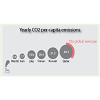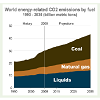Research Article
COP21 Implementation: Strategies or“Muddling Through”
Jan-Erik Lane*
Corresponding author: Jan-Erik Lane, Fellow with Public Policy Institute in Belgrade, Address: 10 Charles Humbert, 1205 Geneva; E-mail: janeklane@gmail.com
Citation: Lane JE. COP21 Implementation: Strategies or “Muddling Through”. J Environ Soc Sci. 2016;3(1): 118.
Copyright © 2015 Lane JE. This is an open access article distributed under the Creative Commons Attribution License, which permits unrestricted use, distribution, and reproduction in any medium, provided the original work is properly cited.
Journal of Environmental and Social Sciences | Volume: 3, Issue: 1
17/01/2016; Accepted: 11/02/2016; Published: 19/02/2016
Abstract
The COP21 Agreement among the governments of the world obliges them to initiate the process of halting or reducing the emission of greenhouse gases, especially CO2:s by 2018-2020. In the social sciences, the commitment calls for decentralised policy-making by the states or nations. The technical term is policy implementation. But the lessons from the policy sciences is that implementation, viz successful implementation is hard to come by. Avoiding lengthy and transaction costly discussions about economic policy measures, the article suggests a simple administrative solution: Dismantle coal fired power stations as much as possible; put strong filters on the remaining ones until they can be abandoned; compensate the biggest emitters of CO2 from the new super fund. Awaiting the massive transfer from fossil fuels to renewables will be too slow process for stemming climate change, however desirable this is.
Keywords: GHG emissions; CO2 emissions; Policy implementation; Coal energy; Reducing CO2:s
Introduction
It may be correct to hail the COP21 approach to the climatechange problematic a turnaround for mankind, establishing withunanimity of governments of the states of the world that total CO2emissions are going to be halted in growth, reduced considerably andfinally completely abolished, even if it would take the entire century!This is all ambitions, promises, talk – i.e. intentions ex ante. Anentirely different matter is the set of outcomes ex post – in reality theimportant aspect of the COP21 approach.
The COP21 Agreement is meant to guide the UN and 195governments/states for almost the entire century. Yet, it is somewhatopaque or ambiguous:
- Is it a treaty or just a promise, i.e. how is it binding?
- Can its implementation be evaluated in a neutral and objectivefashion?
- Can the overall objective be broken down into measurable middle range targets?
- Is there some continuously operating overview mechanism?
- Are there so-called implementation fixers?
- How is the super fund to be operated and by whom?
Given that the global ambition is to show policy results alreadyaround 2020, much attention must be devoted now to implementationissues. Thus, one wants to halt the progression of CO2 emissions asearly as possible and rescue what is left of the rainforests. How toimplement such objectives on a global scale?
The signatories of the COP21 Agreement would benefit fromtaking stock of the huge debate about rational policy-making in thesocial sciences. Is there a rational strategy for decarbonisation in thenations of the world? If so, will it be implemented?
Implementation Theory
The distinction between intention and outcomes became the central point in the social theory of implementation, created by lateAmerican Aaron Wildavsky (1973, 1984) [1,2]. The gulf between theenactment of policy ex ante and its implementation ex post is beset byparadoxes and ambiguity, the more so the loner the time spa betweenex ante and ex post. He studied the following difficulties:
- Un-intended and un-recognizes outcomes
- Flaws in the policy theory about ends and means
- Resistance to change among locals
- Incoherent outcomes necessitating new policies
- Misunderstanding between central policy-makers and localimplementers about objectives and restraints.
Wildavsky rejected the idea of complete implementation orfully successful implementation from a static point of view, as heobserved goal conflicts, different recommendation of means andvarious interpretations of the outcomes, from positive to negative.Instead, implementation of policy decisions at the centre by localimplementers had to be conceived as an evolutionary process wherelearning and change played a major role – a dynamic conception.
In an important paper, Paul Sabatier (1988, 1989) argued thatsuccessful implementation putting the goals into real life outcomesrequires not so much formal organisation and hierarchy of command[3,4]. The so-called “fixers” are the key players in the stage expost the enactment of policy decisions, and they can come fromvarious organisations creating a powerful informal group to handleimplementation.
Finding the “implementation fixers” to manage CO2 emissionsand forest protection will prove tricky, as players at various levels– international, national, regional and local – have to cooperate,including the civil society organisations.
Implementation, or the carrying through of policy, is fraught withstrategic behaviour, including opportunism with guile. How this is tobe controlled in the COP21 approach is going to be a major headache.And the process of implementation will be long.
The Chief Target: CO2 Emissions
Figure 1 presents a nice overview of the greenhouse gases andthe problematic targets of halting CO2 and stop deforestation. SinceCO2 emissions from fossil fuels and deforestation make up such alarge part of the greenhouse gases, they appear promising for policymaking. Reducing deforestation would be doubling significant, astrees and vegetation absorb CO2.
Now, how is the objective to decrease CO2 emissions to beachieved? The main responsibility would fall upon the states,with various levels of governments involved. So the question ofimplementation becomes: Do the implementers know what to andare they will to do it?
The outcomes of the implementation process depend upon threeabstract things:
- Information: technology, innovative skills, organisationalleadership,
- Motivation: belief in the objectives, willingness to contribute,endurance,
- Resistance: conflicts, delays, misunderstandings, goaldisplacement
In an implementation process that takes several years, these threeelements are bound to change or be transformed. This explains whya policy ex ante may be very different in outcomes ex post, as wellas why Wildavsky underlined learning and evolution. The COP21Agreement is bound to meet resistance, open or tacit, because thereare economic costs involved in implementing it. Now, what arethe means available to the urgent implementation of this objective:decarbonisation?
Decarbonisation
CO2 emissions come from almost every sector in the economy,according to Figure 1: energy production, transport, industry,agriculture, forests and biomass, housing, as well as water and waste.Countries will have to start looking at their specific situation in orderto devise a set of decarbonisation policy measures:
1) Massive use of solar power;
2) Increase water power;
3) Closing down of coal power plants;
4) Put coal filter on every coal plant;
5) CCS: trapping and separating the CO2 from other gases,transporting this captured CO2 to a storage location, andstoring that CO2 far away from the atmosphere ;
6) CDR: Sucking CO2 from the atmosphere;
7) Employing much more of natural gas;
8) Expand wind energy;
9) Built more nuclear power stations; use thermal and wavepower; better mileage on cars and trucks; natural gas onbuses; no subsidies to diesel.
Decarbonisation also involves forestry and agriculture: Eliminateor reduce forest fires; Agriculture: change production methods andfood habits to reduce massive emissions of CO2 and also methane.
The policy mix chosen for decarbonisation will depend upon thecountry situation with regard to both emissions and energy sources.Nations that use lots of coal must reduce this dependency quickly.Solar and wind power must be resorted to on a much grander scale.Compare little Denmark that has 40 per cent coming from wind power sources. Can this be imitated in other bigger countries whereit is windy or sunny?
Technological innovations are going to be of utmost importance,like the storing of electricity from solar power, the massive use ofLNG, improved mileage of cars and electricity power cars, new filterson fossil fuels burning stations to capture C02, etc. This is the greatchallenge for engineers and natural scientists in this century.
However, the best solutions do not come about automatically,which the social scientists would remind about. There are so-called“veto-players” in the implementation of the CO21 Agreement:
- Vested industry interests coal, car, agriculture, etc.;
- Quick profits in energy and agriculture;
- State sovereignty concerns;
- A narrow and myopic view on economic development/growth;
- The shipping industries and air transportation industriespolluting a lot with little demand for decrease.
The feasibility of policy implementation has been discussed backand forth in political science, public administration and economics.The pessimism of Wildavsky is shared by those who reject thepossibility of rational decision-making. Instead, they favour theHerbert Simon model of “bounded rationality”, which implies thatsomehow and at some point in time some policies but not all meetwith a few favourable outcomes – government is muddling through(Charles Lindblom). Rational policy-making was rejected as unfeasibleby major scholars theorizing policy-making, stating that rational plansabout ends and means were merely precepts (D. Waldo), or wishfulthinking blending politics and administration, values and science (P.Appleby). Perhaps global policy-making in relation climate change is a “garbage can”, meaning that solutions chase an unknown problemin total confusion, successful implementation is just luck and whennew people take over they come up with other policy identification (J.March and J.P. Olsen).
Yet, global warming cannot wait for the resolution of thefeasibility of rational policy-making, as things press more and more.Thus, the total size of CO2 in the atmosphere keeps going up, despitea small reduction in CO2 emissions 2015: December 6 - 12, 2015:401.31 ppm; December 6 - 12, 2014: 398.93 ppm; December 6 - 12,2005: 379.67 ppm. One may tentatively identify a few reasonableprecepts for a global emission reducing policy.
Implementation Strategies: A few rational precepts
Each nation has to develop its own strategy in order to complywith the COP21 Agreement. The choice of policy measures forimplementation of the goal of halting and reducing greenhouse gases(GHG) or CO2 will take the basic parameters of the country situationin terms of energy consumption into account. One may identitycertain aspects of the entire implementation project that somehowenters how the COP21 framework will fare.
1) When targeting CO2 emissions in policies, it is always thereal outcomes that matter, namely: i) size of total emissions of CO2, ii) total amount of CO2 in the air. Even if the first nolonger increase, the second may still augment.
2) The global warming problematic is not symmetrical amongnations, as a few countries are responsible for much of theemissions of GHG:s or CO2:s.
It is the total size of the GDP that makes a country a major emitter.The fact of the matter is that there is a small set of huge polluters ofGHG:s or CO2:s. If they start decreasing, it would mean a lot. Mostother countries are too small to play a big role in the global warminggame.
Table1 lists the 2014 annual CO2 emissions estimates (inthousands of CO2 tonnes) along with a list of emissions per capita (intonnes of CO2 per year) from same source. The data only considerscarbon dioxide emissions from the burning of fossil fuels and cementmanufacture, but not emissions from land use, land-use change,and forestry. Emissions from international shipping or bunker fuelsare also not included in national figures, which can make a hugedifference for small countries with important ports. The top 10 largestemitter countries account for some 65 per cent of the world total.
During 2015, Indonesia has moved up sharply on the list due to the deforestation of Kalimantan. By targeting the largest emitters ofCO2, major reductions are feasible.
3) One should not target CO2 emissions per capita, because mostly small countries rank high but with small total emissions.
It is only fair that all countries contribute in a global climatechange policy according to the COP21 framework. But the huge gainsare not to be found in Figure 2 with emissions per person.
Although the data in Figure 3 is a little bit old, it shows that mosthuge emitters of CO2 totally speaking do not have the largest CO2emissions per capita, except the US. Today the biggest emissions percapita are to found in the Gulf (Figure 2).
One should of course require that these gigantic emitters –per capita – form part of the CO2 approach, but from the point ofview of a decisively large reduction of CO2:s, they matter little. Theimplementation of COP21 Agreement must target the emitters inTable 1.
4) There is no evidence for an environmental Kuznets’ curvewhen it comes to GHG:s or CO2:s. An EKC would imply thateconomic development or growth solves the global warmingproblem, as emissions per capita would go down with higherGDP per capita.
However, the evidence points at the opposite. The richer a countrybecomes, the more energy it consumes both totally and per capita. Onthe other hand, it holds that the emissions per GDP unit falls, but thisis compensated by increases in GDP!
Thus, the problem will get worse if nothing is done with economicgrowth as the first priority globally.
5) Targeting GHG:s, one should focus on the largest component,namely CO2:s. One may also wish to seek to reduce methaneemissions, but CO2 reduction would have the largest impactand probably quickest.
CO2 emissions constitute more than 75 per cent of all GHG:swith 65 per cent coming from industry, transportation and housingas well as 10 per cent from forestry and land use.
6) Targeting CO2 emissions, one would like to know wherethey come from. It is first and foremost coal that is theculprit.
Now, the emissions such as CO2 vary by various fuels of energy.Different fuels emit different amounts of carbon dioxide (CO2)in relation to the energy they produce when burned. To analyzeemissions across fuels, compare the amount of CO2 emitted per unitof energy output or heat content Table 2.
The amount of CO2 produced when a fuel is burned dependsupon its carbon content. Heat content, i.e. the amount of energyproduced by a fuel, is a function of the carbon (C) and hydrogen (H)content of the fuel. Thus, heat is produced when C and H combinewith oxygen (O) during combustion. Natural gas is primarilymethane (CH4). It is important to point out that methane has higherenergy content relative to other fuels. It has a relatively lower CO2-to-energy content. Water and various elements, such as sulfur andnon-combustible elements in some fuels reduce their heating valuesand increase their CO2-to-heat contents Figures 4,5.
Besides targeting coal replacing it or employing filters to reduceCO2:s, one must look at energy efficiency globally, from one countryto another.
7) If coal is replaced as a major energy source by natural gas orrenewables, the COP21 objectives would be implemented nodoubt.
Conclusion
COP21 and Coal Power
It seems reasonable to target coal first and foremost. Nationsshould be convinced not to construct them anymore, to close themdown if old, and to put strong filters upon them if young. This policyrecommendation should be followed by the largest emitter, listedabove. If this policy is costly to implement, then the super fundshould be employed for compensation. Removing the CO2 emissionsfrom coal would go a long way towards saving Planet Earth and itsinvaluable environment for sustainable life conditions for all species,including humans.
References
- Pressman J, Wildavsky A (1973) Implementation. Berkeley: University of California Press.
- Pressman J, Wildavsky A (1984) Implementation, 3rd edition. Berkeley: University of California Press.
- Sabatier P (1988) An advocacy coalition framework of policy change and the role of policy-oriented learning therein. Policy Sciences 21: 129-168.
- Mazmanian D, Sabatier P (1989) Implementation and Public Policy. Glencoe, Ill.: Scott Foresman & Company. Second edition by University Press of America.
- Energy Information Administration (EIA). Washington, DC.
- International Energy Organisation. Paris.







